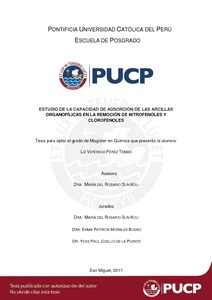| dc.contributor.advisor | Sun Kou, María del Rosario | |
| dc.contributor.author | Pérez Tomas, Liz Verónica | es_ES |
| dc.date.accessioned | 2017-06-20T17:43:56Z | es_ES |
| dc.date.available | 2017-06-20T17:43:56Z | es_ES |
| dc.date.created | 2017 | es_ES |
| dc.date.issued | 2017-06-20 | es_ES |
| dc.identifier.uri | http://hdl.handle.net/20.500.12404/8849 | |
| dc.description.abstract | El presente trabajo se centró en el estudio de la capacidad de adsorción del fenol, 2- nitrofenol, 2,4-dinitrofenol, 2-clorofenol y 2,4-diclorofenol utilizando arcillas organofílicas (CPHDTMA y FS-HDTMA) como adsorbentes. Además, se evaluó el efecto de la naturaleza de la arcilla y el efecto que pueden tener los grupos funcionales (-NO2 y -Cl) mono- y disustituido en el fenol en la capacidad de adsorción. Las arcillas organofílicas fueron preparadas por intercambio catiónico a partir de una arcilla natural (FS) y una arcilla homoionizada (CP), utilizando como catión amónico el hexadeciltrimetilamonio (HDTMA). La caracterización fisicoquímica se realizó mediante DRX, SEM-EDX, FTIR, TG, sorción de N2, acidez y basicidad y punto de carga cero, con lo que se pudo conocer la morfología, la estructura y las propiedades superficiales de los materiales adsorbentes En base a la capacidad de adsorción se observó el siguiente orden de retención de los adsorbatos: fenol < monosustituidos < disustituidos. La mayor adsorción se obtuvo con la CPHDTMA. Los resultados de las isotermas mostraron que la adsorción se llevó a cabo sobre una superficie mixta, donde la energía de adsorción se redujo con el grado de ocupación de los sitios activos. El proceso de adsorción se llevó a cabo por una combinación del mecanismo de partición y de atracción electrostática. El pH tuvo un rol importante en la capacidad de adsorción, ya que influyó en la carga superficial del adsorbente. El incremento de la fuerza iónica mejoró la capacidad de adsorción, este comportamiento fue explicado por el efecto de salting out. Se evidenció una mayor adsorción de los clorofenoles por ser de carácter más hidrofóbico que los nitrofenoles, en estos últimos la adsorción fue proporcional a su polaridad, mientras que en los clorofenoles la adsorción fue proporcional a su constante de partición log Pow. | es_ES |
| dc.description.abstract | The present work is based on the study of the adsorption capacity of phenol, 2- nitrophenol, 2-chlorophenol, 2,4-dinitrophenol and 2,4-dichlorophenol using organophilic clays (CP-HDTMA and FS-HDTMA) as adsorbents. The favorable adsorption conditions were evaluated, as well as the influence of -NO2 or –Cl in phenol mono and disubstituted on the adsorption process.
Organophilic clays were prepared by cation exchange with hexadecyltrimethylammonium (HDTMA) as the ammonium cation and natural clays (FS) and homoionic clay (CP). The physicochemical characterization of the materials was performed using XRD, SEM-EDX, FTIR, TG, N2 sorption, Boehm titration and point of zero charge; this allowed understanding the morphology, the structure and the surface properties of adsorbent materials.
The best-fit model for the kinetic curves was the pseudo-second order model based on the adsorption capacity the following order of retention of the adsorbates was observed: phenol<monosubstituted<disubstituted. The highest adsorption was obtained with CP-HDTMA. Results showed that the adsorption was carried out on a heterogeneous surface, where the adsorption energy was reduced with the degree of occupation of the active sites. The pH had an important role in the adsorption capacity of the studied phenolic compounds. The adsorption process was carried out by a combination of partitioning mechanism and electrostatic attraction. The effect of ionic strength suggested an improvement in the adsorption capacity when the electrolyte concentration increases, this behavior can be explained by salting out effect.
Higher adsorptions of chlorophenols were obtained because they are more hydrophobic than nitrophenols. In the latter the adsorption was proportional to its polarity and in the chlorophenols groups the adsorption was proportional to its partition constant log Pow. | es_ES |
| dc.description.uri | Trabajo de investigación | es_ES |
| dc.language.iso | spa | es_ES |
| dc.publisher | Pontificia Universidad Católica del Perú | es_ES |
| dc.rights | info:eu-repo/semantics/openAccess | es_ES |
| dc.rights.uri | http://creativecommons.org/licenses/by-nc-nd/2.5/pe/ | * |
| dc.subject | Adsorción | es_ES |
| dc.subject | Fenoles | es_ES |
| dc.subject | Arcilla--Análisis | es_ES |
| dc.title | Estudio de la capacidad de adsorción de las arcillas organofílicas en la remoción de nitrofenoles y clorofenoles | es_ES |
| dc.type | info:eu-repo/semantics/masterThesis | es_ES |
| thesis.degree.name | Magíster en Química | es_ES |
| thesis.degree.level | Maestría | es_ES |
| thesis.degree.grantor | Pontificia Universidad Católica del Perú. Escuela de Posgrado | es_ES |
| thesis.degree.discipline | Química | es_ES |
| renati.advisor.dni | 10831187 | |
| renati.discipline | 531057 | es_ES |
| renati.level | https://purl.org/pe-repo/renati/level#maestro | es_ES |
| renati.type | http://purl.org/pe-repo/renati/type#trabajoDeInvestigacion | es_ES |
| dc.publisher.country | PE | es_ES |
| dc.subject.ocde | https://purl.org/pe-repo/ocde/ford#1.04.00 | es_ES |






